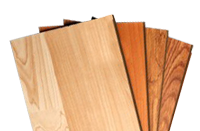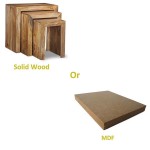Why you Should Choose Solid Wood Over MDF
When it comes to the inevitable debate over the choice of solid wood as opposed to MDF (medium density fibreboard) the general consensus is that, as with all products, you simply cannot beat the real thing.
That is not to suggest that there is nothing good about MDF; it does have its advantages. So, for the sake of argument, we will deal with those first.
The main ones are these: modern designers argue that veneer is essential when using large expanses of flat surface, as with much of the currently popular modern minimalist pieces for which consistency of pattern and colour are important, and the flat panels of wood veneer, as in MDF, are far less likely to warp.
There are other issues which prompt intensive debate and, when it comes to the nitty-gritty, what you decide on depends on your own personal taste – or maybe even your budget.
Sometimes you can get bogged down in the theory and the opinions, and quite often it is a problem separating fact from fiction.
In any event, the veneer suppliers and supporters will point out that MDF has not only been used for centuries as a common substitute for solid wood, it is now a greatly improved product.
The key word here, however, is 'substitute'. Why make do with a substitute when you can have the real thing. Would Barcelona put a substitute on the pitch if they had Lionel Messi available?
You could also say that MDF is a watered down version of solid wood because the panels are notorious for their relatively low strength and a tendency to swell if water gets at them.
Consider this as well. If the furniture in question is liable to a certain amount of rough, tough usage, not to mention the usual wear-and-tear – and that applies to the vast majority of households, particularly those where young children are careering around oblivious to any damage they might inflict on the woodwork, not to mention themselves, then, to use a term in common usage, it is a no-brainer. It has to be solid wood.
You see, when solid wood receives a chip or a dent it is still the same underneath. It is solid through and through.
When it is scratched or scuffed or scorch-marked it can be sanded down and made like new again.
Even if it is left unrepaired solid wood furniture can still look good. In fact, some people argue that worn edges and the odd dent add a certain amount of appeal.
These are enviable advantages of solid wood. Its surface ages well and dents and scratches can create an attractive finish. If damage becomes too great it can be smartened up by sanding it down and re-finishing with wax or polish.
You simply cannot beat solid wood for durability. Treat it with a little bit of TLC and it will last you a lifetime – and look every bit as handsome as when you first bought it.
On the other hand, a chipped edge of veneer reveals the entirely different strata underneath which makes it very difficult to repair properly.
There are other 'substitute' options available these days, but wood connoisseurs will tell you that there is a durability, a dependability, and a real delight in items which are made out of solid wood.
You have only to compare solid wood and MDF at close quarters to realise that there is no comparison.
You'll find with Solid Wood Furniture that it will be pleasing to the eye; you can also rest assured that it will continue to look good; and it will last you a lifetime.
What more could you ask for?


